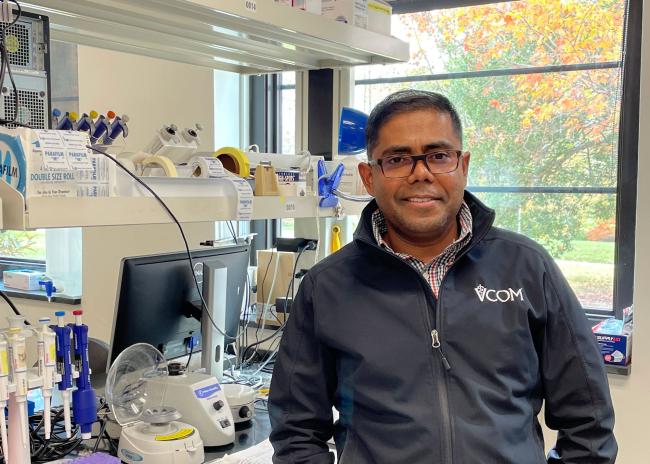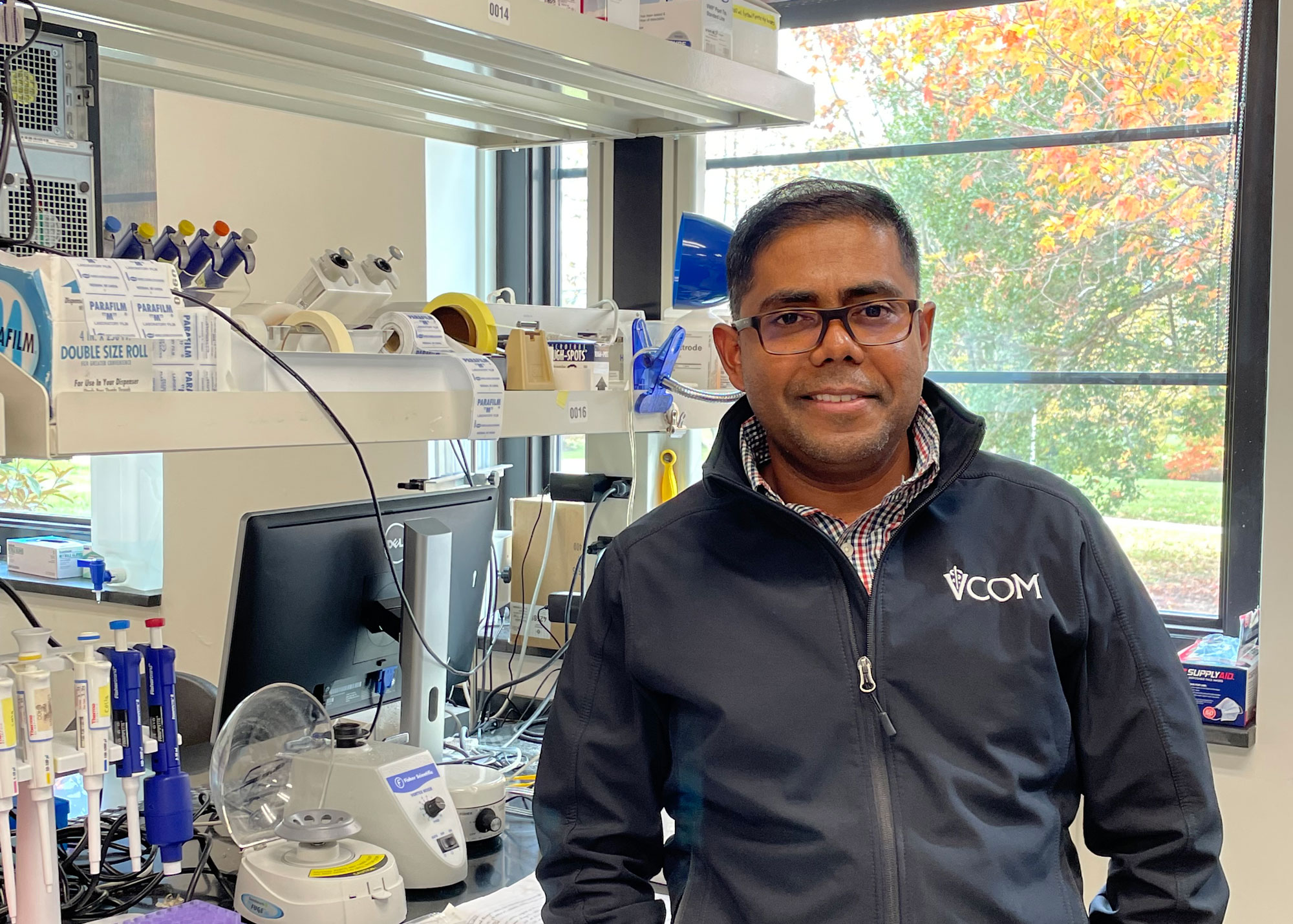
According to the Cleveland Clinic, neurological disorders—Alzheimer’s, Parkinson’s, Huntington’s and others—may affect more than 50 million people worldwide. The World Health Organization estimates that approximately 280 million people in the world suffer from depression. The American Psychiatric Association estimates that 3.5% of Americans are affected by post-traumatic stress disorder each year.
Clearly, neurological and mental health challenges are a huge issue in the United States and around the world, but many of these conditions have limited treatment options. Blaise Costa, MPharm, PhD, hopes his research will one day change that.
Costa is VCOM-Virginia’s discipline chair for pharmacology. Pharmacologists research and test new drugs and treatment strategies to benefit patients, but this research is difficult, expensive and often fails. In the classroom, Costa teaches students how drugs work in the human body and how they interact with each other. In addition to his teaching duties at VCOM, Costa also works at the Virginia Tech Center for One Health Research (COHR), which is a facility that integrates faculty, staff and students from VCOM and the Virginia Maryland College of Veterinary Medicine to do research projects.
In his COHR lab, Costa is researching novel treatment strategies for neuropsychiatric disorders. He is specifically looking at the N-methyl-D-aspartate (NMDA) receptor in the brain, which “receives” glutamate, an amino acid created by the brain. Glutamate is a neurotransmitter, bringing excitatory messages from one neuron to another. In a normally functioning brain, glutamate binds to NMDA receptors and helps with learning and memory formation. The brain is essentially like a computer circuit board, but with the ability to constantly rewire itself based on our everyday experiences. Neurons build these new pathways based on the quantity and frequency of glutamate and other similar chemical messengers released by the brain cells.
Costa likens the system to a game of football, in which glutamate—the football—is being caught by the NMDA receptors—the wide receivers.
There are several problems that can happen within the system. One is that the NMDA wide receivers might be randomly running in the field or maybe the equipment folks brought too many footballs to the game. In either case, there is too much glutamate in the brain with no way for the receptors to catch it all. This kind of hyperactivity, known as excitotoxicity, can kill neurons. This is what happens after a stroke. Studies indicate that excitotoxicity and the resulting cell death may also be part of what causes Alzheimer’s Disease. Alternatively, the equipment folks may have neglected to bring any footballs and there is no glutamate at all in the system. This lack of glutamate can lead to issues like schizophrenia, major depression and post-traumatic stress disorder, among others.
The goal, Costa says, is to have about the right amount of glutamate for the receptors. He is researching a drug compound called CNS4 to determine if it can help regulate the system, making the NMDA receptors more effective and ensuring that there is neither too much, nor too little, glutamate in the brain.
“This is complicated in many ways,” Costa says. “There are hundreds of variants of the NMDA receptor, and they can be created by lifestyle and medical conditions. It took me more than 20 years to study the normal function, abnormalities and activities of potential therapeutic agents like CNS4.”
There are more than a hundred million possible compounds to study. Using his expertise, Costa synthesized five to study by doing some extremely educated guessing to select the ones he would focus on. One of those compounds was CNS4. In 2017, Costa discovered that CNS4 worked the way he expected in modulating the response of glutamate in isolated NMDA receptors.
The next step was to work with Gunnar Brolinson, DO, VCOM’s vice president for research, to develop intellectual property protections for Costa’s work. The U.S. and international applications to patent the research Costa has done are currently under examination.
So, then what?
The goal, ultimately, is to develop a treatment for imbalances in glutamate that will improve the health of patients across the globe. Costa says that there is also some potential to develop a non-opioid pain drug, which is a high priority for the United States.
Of course, drug development is an incredibly long, complicated and expensive process. The first step is to develop a hit compound. Costa has done that through the discovery of CNS4. He’s now in the “hit to lead” part of the process and is applying for grants from the National Institutes of Health (NIH) to support his research. For the next few years, Costa will develop analog compounds of CNS4 and test how effective they are in modulating glutamate. Compounds that show a particular promise may become leads.
After that, the process generally moves to drug companies, which have more resources to devote to turning a lead into a marketable drug. This part of the process can take up to a decade and cost about $1 billion.
